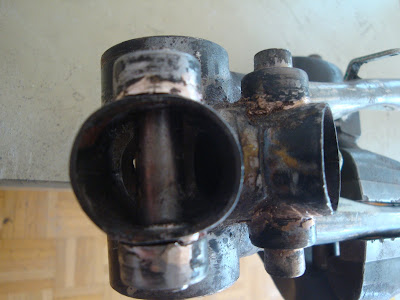The donor bicycle had a Sachs Huret Commander hybrid derailleur and internal hub gear with 12 speeds (6x2). Note the bent rear rim, by the way.

The origins of this derailleur goes back to 1980, when Fichtel and Sachs bought the French bicycle component manufacturer Huret. They combined the 2-speed internal gear hub "Orbit" by Sachs with a Huret derailleur in versions of 5x2, 6x2 and 7x2.


This type of gear was popular during the 80s, specially for street bicycles with 28" wheels for urban transport. It was sold with the Sachs-Commander lever system for control, with two levers placed at hand in the handlebar, one controlling the internal gear hub and the other the derrailleur. The levers had defined steps with notches to engage, what was not common in the 80s, as friction levers was the usual. The very straightforward shifting and the reliable operation of this gear system contributed to the popularity among the general public of non-specialized cyclists.

Those of you willing to learn more about the history and technical features of this bicycle gear, are referred to the following sites:
http://www.disraeligears.co.uk/Site/Sachs-Huret_Commander_derailleur_-_instructions.htmlhttp://www.karstilo.net/hpv/technik/sachs_sram/2gang/index.phpAt the beginning I planned to recycle the Sachs-Huret Commander, as it fitted the requirements of this bike. I disassembled the wheel and took the internal hub apart. Luckily I found in the web the assembly schematics and the manuals. In the following pictures the disassembled hub can be seen.

It has 2 gears: High, or direct transmission through the engaging of the pawls in the central axis assembly with the ratchet mounted in the aluminium casing; and low gear with a ratio of 0,74:1 via 3 planetary gears and the sun gear machined in the central shaft.

I cleaned, greased and put the hub back together. It was in good working condition. On the other hand, I cleaned and oiled the derailleur and control levers.
However, one day I was talking to a colleage at work who is also interested in bicycle projects and he offered me a Sachs Pentasport 5 gear internal hub, as he had one in his cellar since long with no prospects of ever using it in his projects. Thanks, André!
At first you might think that this was not a good idea, as I would decrease the functionality from 12 speeds of the Sachs-Huret to only 5 speeds of the Pentasport. This, however, is not correct. The Sachs-Huret, was created by merging 2 existing products into one. The final result, was a gear system reliable and easy to operate in street bikes, but the spacing of the gears is not optimized, as the high and low ranges are largely superimposed. This means that not all 12 gears are of practical use, as many combinations are redundant. Morever, the most important feature is the range from maximum to minimum transmission ratio.
In the following table I compared three scenarios: Sachs-Huret Commander 6x2, Sachs Pentasport and a Sturmey Archer AW 3-speed (I have many of these around in my cellar).

You see that the Sachs Pentasport, with a more compact and modern design, covers the same range of transmission ratio from 3,3m to 7,5m per pedal revolution with only 5 speeds, commanded by a single trigger-type lever. The Sachs Huret has superimposed ratios in the ranges L4-L6 and H1-H4, so that there are only 8 meaningful transmission ratios that can be achieved. On top of that, the lower ratios L1-L4 are grouped very tight together, making some of them redundant. The Sturmey-Archer, on the other hand, could be confortably used only in gentle slopes as the lower ratio starts from 4m per pedal revolution. I expect this bicycle to climb slopes up to 8%. Then, the Pentasport is the best of the three options.
Here it is, the Pentasport internal gear hub, duriing the process of frame development after the design-as-you-go methodology.




















































